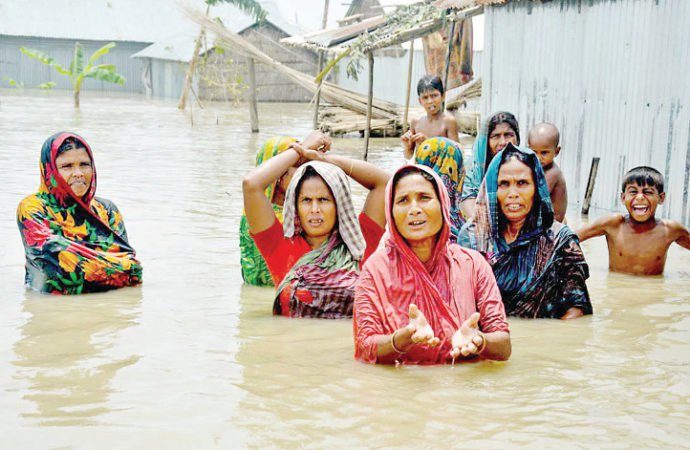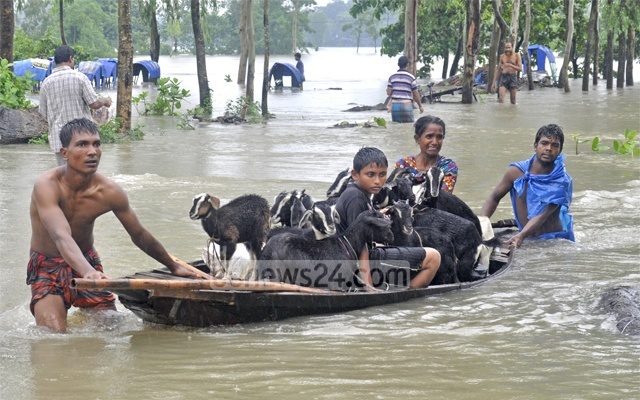
At least 57 people have died in 13 districts, as of 6pm on Wednesday, due to the monsoon flood that is currently plaguing the country's northern and northeastern regions, according to disaster management officials.
The highest number of deaths occurred in Dinajpur, where 23 people have died, while Kurigram has the second highest death toll - nine.
Some of the victims were swept away by floodwater, some died from snake bites and lightning and others were crushed when walls collapsed on them, said the officials.
Around 3,326,864 people in 22 districts have been severely affected by the latest bout of flood that hit last week, their houses and croplands inundated, according to the Flood Monitoring Cell of the Department of Disaster Management.
However, local sources say the real count of death toll and damage is bigger than the government numbers.
Relief efforts
The government has already opened flood and relief centres as part of its relief and rehabilitation works, where 471,553 people have already taken shelter, said the Department of Disaster Management sources.
However, shortage of food grains in its stock is causing problems in the relief distribution process.
The sources said the government had already allotted 321,259 tons of rice for the flood-affected people, 3,387 tons of which has already been distributed.
As of Tuesday (August 15), the government's rice reserve for Gratuitous Relief (GR) is only 1,517 tons against the demand of 5,335 tons, according to the department's flood situation report.
Sources at the Ministry of Food say as of Wednesday, the government reserve of food grains stands at 434,000 tons - 287,000 tons of rice and 147,000 tons of wheat.
The government reserve is mainly for covering its different social safety net programmes including Vulnerable Group Feeding (VGF), Vulnerable Group Development (VGD), Open Market Sale (OMS) and Gratuitous Relief (GR).
Due to the food grain shortage, the government has already suspended its VGF programme for the Haor basin in Sylhet division which was badly affected by flash floods in April.
On Wednesday, the government decided to import 1.5 million tons of rice and 500,000 tons of wheat to tackle the crisis.
In addition, it decided to reduce the rice import duty to 2% to encourage rice import in private sector.
At an event in Dhaka on Wednesday, Finance Minister AMA Muhith said there was no food crisis in the country due to the persisting flood and there would be no crisis in the future either, reports UNB.
However, he admitted that the flood had caused temporary losses which would be overcome soon. "For that, we have to spend more money and we have this capacity," he said.
The current situation
The floodwater has started to recede in some flood-affected districts, including Thakurgaon, Dinajpur, Nilphamari, Lalmonirhat and Kurigram, according to the Flood Forecasting and Warning Centre (FFWC).
The FFWC flood bulletin, issued on Wednesday, said the water flow in the Ganges-Padma River is in the rising trend, while the Brahmaputra-Jamuna and the Surma-Kushiyara rivers are in the falling trend.
The Brahmaputra-Jamuna River is likely to become steady in the next 24 hours.
The Ganges-Padma River is likely to continue rising in the next 72 hours, while the Surma-Kushiyara River is likely to continue falling in the next 24 hours.
Tough days ahead for the central region
On Sunday (August 13), the FFWC projected that the water level in the Brahmaputra was supposed to cross the danger level - 19.5m - at Bahadurabad point by yesterday (August 16). The water level at that point was recorded at 20.84m on Wednesday, exceeding last year's 20.71m - the highest ever recorded.
The FFWC further predicted that the water level of the Ganges - which takes the name Padma in Bangladesh - will also cross the danger level by Friday or Saturday (August 18-19).
The FFWC data also says the water in the Padma River at Goalando and Bhagyakul points was flowing 77cm and 15cm, respectively, above the danger level on Wednesday.
Water level in the Meghna river basin is also likely to rise as many of the rivers, including the Surma and the Kushiyara, have already seen the water level rise above the danger level.
Speaking to the Dhaka Tribune, hydrologist Prof Ainun Nishat said the latest data suggested that the water level in the three major rivers systems - Jamuna, Padma and Meghna - would reach their peak between Friday and Sunday (August 18 and August 20).
Added to that is the new moon phase that falls during the same period of time, which will result in high tide in the Bay of Bengal. Because of the high tide, the water in the swelled-up river systems will not be able to flow downwards to the sea, he added.
If that happens, large areas of central Bangladesh, including Munshiganj, Faridpur, Madaripur, Shariatpur, Tangail, Kushtia and some parts of East Dhaka city will be inundated for at least 10-12 days, he cautioned.
According to Bangladesh Meteorological Department, the country experienced severe rainfall in different parts of the country in the last 24 hours as of 6pm on Wednesday. The weather is likely to remain the same in the next 24 hours as well.




Reader Comments
to our Newsletter